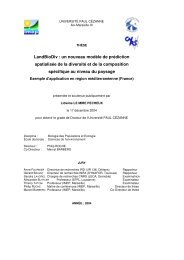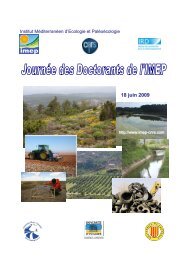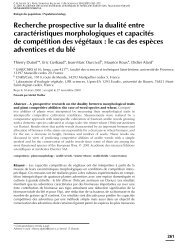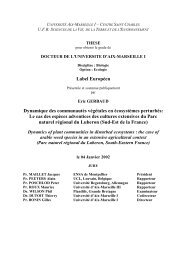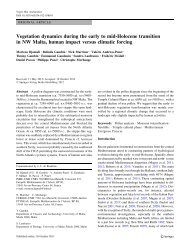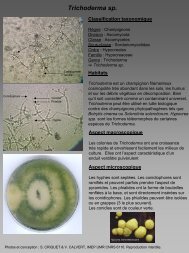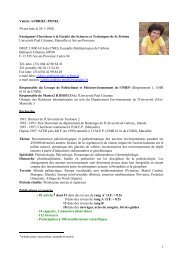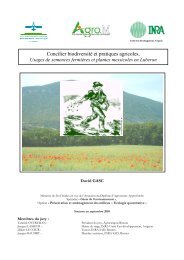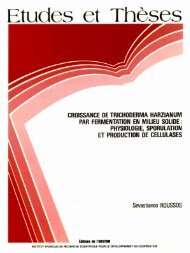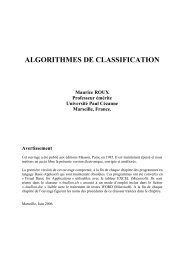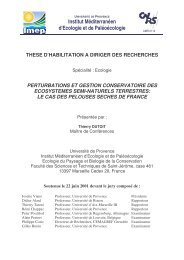UNIVERSITÉ PAUL CÉZANNE, AIX MARSEILLE III - IMEP
UNIVERSITÉ PAUL CÉZANNE, AIX MARSEILLE III - IMEP
UNIVERSITÉ PAUL CÉZANNE, AIX MARSEILLE III - IMEP
You also want an ePaper? Increase the reach of your titles
YUMPU automatically turns print PDFs into web optimized ePapers that Google loves.
1. Introduction<br />
Résultats et discussion. Chapitre 3: Evaluation des facteurs de croissance<br />
The importance of olive oil mill industry in Mediterranean countries is well known, as<br />
well as the serious problems that olive mill factories have in disposing their by-products<br />
(Cayuela et al., 2006, Altieri and Esposito 2008). Commonly, olive mills produce residual<br />
solids, the olive cake (OC) which make up a fibrous lignocellulosic waste and generally used<br />
as fuel (Ait Baddi et al., 2009); and a black liquid effluent, the olive mill wastewater or<br />
(OMW), which is a strong pollutant mainly due to its high phenolic content and organic load<br />
(Mekki et al., 2007). In addition, it has been estimated that each olive tree could produces 25<br />
kg leaves and twigs per year (Fayed et al., 2009).<br />
In the past, several investigations were carried out to select microorganisms (notably<br />
fungi) capable of eliminating the inhibitory effects of those substances and of converting the<br />
initial waste either directly into a useful end-product or by making it susceptible to further<br />
physicochemical and biological treatments (Jaouani et al., 2003; Lakhtar et al., 2009). Among<br />
Basidiomycotina in particular, white-rot fungi belonging to the genus Pleurotus and Lentinula<br />
were selectively tested for their ability to decompose the lignin and are among the most<br />
efficient producers of lignocellulosic enzymes (Elisashvili et al., 2008). In addition, they can<br />
be cultivated on a large lignocellulosic substrates transforming them into food and feed<br />
(Zhang et al., 1995).<br />
Lentinula edodes (Berk.) Pegler (shiitake) is the second most popular edible<br />
mushroom in the world because of its flavor, taste and quality ((Tsai et al., 2009)). In<br />
addition, L. edodes is one of the best known and the best characterized mushrooms used for<br />
medicinal purposes (Hadar and Dosoretz 1991; Hirasawa et al., 1999; Hatvani 2001; Gu and<br />
Belury 2005; Israilides et al., 2008; Shen et al., 2009). Owing to L. edodes characteristic,<br />
different substrate formulations have been developed in different countries, depending on<br />
their readily available raw material. Agricultural wastes such as oak, cereal straw, corn cobs,<br />
sugarcane bagasse are used alone or in combination with other wastes in L. edodes cultivation<br />
(Sunchez et Royse 2001; Philippoussis et al., 2003; Kalmis et Sargin 2004; Özçelik and<br />
Peksen 2007; Philippoussis et al., 2007). However, for the first time, the use of mixture of<br />
olive cake, olive twigs and leaves supplemented with OMW is reported.<br />
To determine the parameters affecting biomass production of L. edodes and<br />
polyphenol removal from OMW, with the intention to optimize the conditions of solid state<br />
fermentation, the set of factors influencing the growth of L. edodes on olives residues was<br />
92



